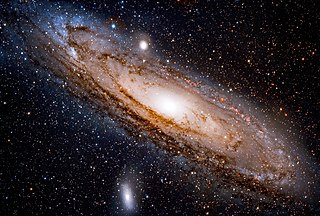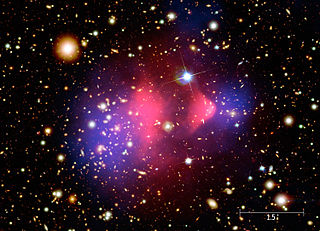
Dark matter is a hypothetical form of matter thought to account for approximately 85% of the matter in the universe. Dark matter is called "dark" because it does not appear to interact with the electromagnetic field, which means it does not absorb, reflect, or emit electromagnetic radiation and is, therefore, difficult to detect. Various astrophysical observations – including gravitational effects which cannot be explained by currently accepted theories of gravity unless more matter is present than can be seen – imply dark matter's presence. For this reason, most experts think that dark matter is abundant in the universe and has had a strong influence on its structure and evolution.

Fornax is a constellation in the southern celestial hemisphere, partly ringed by the celestial river Eridanus. Its name is Latin for furnace. It was named by French astronomer Nicolas Louis de Lacaille in 1756. Fornax is one of the 88 modern constellations.

A galaxy is a gravitationally bound system of stars, stellar remnants, interstellar gas, dust, and dark matter. The word is derived from the Greek galaxias (γαλαξίας), literally 'milky', a reference to the Milky Way galaxy that contains the Solar System. Galaxies, averaging an estimated 100 million stars, range in size from dwarfs with less than a hundred million stars, to the largest galaxies known - supergiants with one hundred trillion stars, each orbiting its galaxy's center of mass.

A globular cluster is a spheroidal conglomeration of stars. Globular clusters are bound together by gravity, with a higher concentration of stars towards their centers. They can contain anywhere from tens of thousands to many millions of member stars. Their name is derived from Latin globulus. Globular clusters are occasionally known simply as "globulars".

A supercluster is a large group of smaller galaxy clusters or galaxy groups; they are among the largest known structures in the universe. The Milky Way is part of the Local Group galaxy group, which in turn is part of the Virgo Supercluster, which is part of the Laniakea Supercluster. The large size and low density of superclusters means that they, unlike clusters, expand with the Hubble expansion. The number of superclusters in the observable universe is estimated to be 10 million.

Star clusters are large groups of stars. Two main types of star clusters can be distinguished: globular clusters are tight groups of ten thousand to millions of old stars which are gravitationally bound, while open clusters are more loosely clustered groups of stars, generally containing fewer than a few hundred members, and are often very young. Open clusters become disrupted over time by the gravitational influence of giant molecular clouds as they move through the galaxy, but cluster members will continue to move in broadly the same direction through space even though they are no longer gravitationally bound; they are then known as a stellar association, sometimes also referred to as a moving group.

A galaxy cluster, or cluster of galaxies, is a structure that consists of anywhere from hundreds to thousands of galaxies that are bound together by gravity with typical masses ranging from 1014–1015 solar masses. They are the second largest known gravitationally bound structures in the universe after galaxy filaments and were believed to be the largest known structures in the universe until the 1980s, when superclusters were discovered. One of the key features of clusters is the intracluster medium (ICM). The ICM consists of heated gas between the galaxies and has a peak temperature between 2–15 keV that is dependent on the total mass of the cluster. Galaxy clusters should not be confused with star clusters, such as galactic clusters—also known as open clusters—which are structures of stars within galaxies, or with globular clusters, which typically orbit galaxies. Small aggregates of galaxies are referred to as galaxy groups rather than clusters of galaxies. The galaxy groups and clusters can themselves cluster together to form superclusters.

The Andromeda Galaxy, also known as Messier 31, M31, or NGC 224 and originally the Andromeda Nebula, is a barred spiral galaxy with diameter of about 46.56 kiloparsecs approximately 2.5 million light-years from Earth and the nearest large galaxy to the Milky Way. The galaxy's name stems from the area of Earth's sky in which it appears, the constellation of Andromeda, which itself is named after the princess who was the wife of Perseus in Greek mythology.

The Virgo Supercluster or the Local Supercluster is a mass concentration of galaxies containing the Virgo Cluster and Local Group, which itself contains the Milky Way and Andromeda galaxies, as well as others. At least 100 galaxy groups and clusters are located within its diameter of 33 megaparsecs. The Virgo SC is one of about 10 million superclusters in the observable universe and is in the Pisces–Cetus Supercluster Complex, a galaxy filament.

The observable universe is a ball-shaped region of the universe comprising all matter that can be observed from Earth or its space-based telescopes and exploratory probes at the present time, because the electromagnetic radiation from these objects has had time to reach the Solar System and Earth since the beginning of the cosmological expansion. There may be 2 trillion galaxies in the observable universe, although that number was reduced in 2021 to only several hundred billion based on data from New Horizons. Assuming the universe is isotropic, the distance to the edge of the observable universe is roughly the same in every direction. That is, the observable universe is a spherical region centered on the observer. Every location in the universe has its own observable universe, which may or may not overlap with the one centered on Earth.

A dwarf galaxy is a small galaxy composed of about 1000 up to several billion stars, as compared to the Milky Way's 200–400 billion stars. The Large Magellanic Cloud, which closely orbits the Milky Way and contains over 30 billion stars, is sometimes classified as a dwarf galaxy; others consider it a full-fledged galaxy. Dwarf galaxies' formation and activity are thought to be heavily influenced by interactions with larger galaxies. Astronomers identify numerous types of dwarf galaxies, based on their shape and composition.

NGC 5170 is a large, nearby, edge-on spiral galaxy in the equatorial constellation of Virgo. It was discovered on February 7, 1785 by William Herschel. This galaxy is located at a distance of 83.5 million light years and is receding at a heliocentric radial velocity of 1,502 km/s. It is a member of the Virgo II Groups, a series of galaxies and galaxy clusters strung out from the southern edge of the Virgo Supercluster.

El Gordo is the largest distant galaxy cluster observed at its distance or beyond, as of 2011. As of 2014, it still holds the record for being the largest distant galaxy cluster to have been discovered with a mass of three quadrillion suns. It was found by NASA's Chandra X-ray Observatory, Atacama Cosmology Telescope—funded by National Science Foundation, and European Southern Observatory's Very Large Telescope.

Cosmic voids are vast spaces between filaments, which contain very few or no galaxies. The cosmological evolution of the void regions differs drastically from the evolution of the Universe as a whole: there is a long stage when the curvature term dominates, which prevents the formation of galaxy clusters and massive galaxies. Hence, although even the emptiest regions of voids contain more than ~15% of the average matter density of the Universe, the voids look almost empty for an observer. Voids typically have a diameter of 10 to 100 megaparsecs ; particularly large voids, defined by the absence of rich superclusters, are sometimes called supervoids. They were first discovered in 1978 in a pioneering study by Stephen Gregory and Laird A. Thompson at the Kitt Peak National Observatory.

The XDCPJ0044.0-2033 (Gioello) galaxy cluster at redshift z=1.579 was discovered in the archive of the XMM-Newton mission, as part of the XMM-Newton Distant Cluster Project (XDCP) and first published by Santos et al. 2011. Gioiello is the most distant massive galaxy cluster that has been found and studied today. This massive galaxy cluster contains 400 trillion times the mass of the Sun and is located 9.6 billion light years away from Earth. The name Gioiello, meaning "jewel" in Italian, was given to this massive galaxy cluster because an image of the cluster contains many beautiful pink, purple, and red sparkling colors from the hot X-ray–emitting gas and other star-forming galaxies within the cluster.

The Bullet Galaxy (RXC J2359.3-6042 CC) is a galaxy in the galaxy cluster RXC J2359.3-6042 (Abell 4067 or ACO 4067). The Bullet Galaxy is the sole component of one half of a cluster merger between the bulk of the cluster and this galaxy, which is plowing through the cluster, similar to how merging clusters Bullet Cluster and Bullet Group have merged. Unlike those two mergers, the Bullet Galaxy's merger is between one galaxy and a galaxy cluster. The cluster merger is happening at a lower speed than the Bullet Cluster, thus allowing the core of the Bullet Galaxy to retain cool gas and remain relatively undisturbed by its passage through the larger cluster. This cluster merger is the first one observed between a single galaxy and a cluster. The galaxy and cluster lies at redshift z=0.0992, some 1.4×109 ly (4.3×108 pc) away. The galaxy is traveling through the cluster at a speed of 1,310 km/s (2,900,000 mph).

The Saraswati Supercluster is a massive galaxy supercluster about 1.2 gigaparsecs (4 billion light years) away within the Stripe 82 region of SDSS, in the direction of the constellation Pisces. It is one of the largest structures found in the universe, with a major axis in diameter of about 200 Mpc (652 million light years). It consists of at least 43 galaxy clusters, and has the mass of 2 × 1016 M☉, forming a galaxy filament.

SMACS J0723.3–7327, commonly referred to as SMACS 0723, is a cluster of galaxies about 4 billion light years from Earth, within the southern constellation of Volans. It is a patch of sky visible from the Southern Hemisphere on Earth and often observed by the Hubble Space Telescope and other telescopes in search of the deep past. It was the target of the first full-color image to be unveiled by the James Webb Space Telescope, imaged using NIRCam, with spectra included, showing redshifts implying objects 13.1 billion years old. It has been previously observed by the Hubble Space Telescope as part of the Southern MAssive Cluster Survey (SMACS), as well as Planck and Chandra.


















